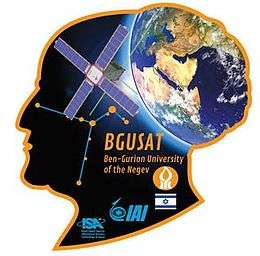BGUSAT
BGUSAT is an Israeli research CubeSat built by the IAI and Ben Gurion University.
 BGUSAT satellite mission patch | |
| Mission type | Earth observation Technology |
|---|---|
| Operator | ISA/Ben-Gurion University of the Negev |
| COSPAR ID | 2017-008BD |
| SATCAT no. | 41999 |
| Website | wwwee |
| Spacecraft properties | |
| Manufacturer | IAI Ben-Gurion University of the Negev |
| Launch mass | 5 kilograms (11 lb) [1] |
| Dimensions | 30 x 10 x 10 cm (3U cubesat) |
| Start of mission | |
| Launch date | 15 February 2017 3:58 UTC [2] |
| Rocket | PSLV-C37 |
| Launch site | Sriharikota Launching Range |
| Contractor | ISRO |
| Entered service | 15 February 2017 3:58 UTC [2] |
| Orbital parameters | |
| Reference system | Geocentric |
| Regime | LEO |
| Perigee altitude | 505 km |
| Apogee altitude | 505 km |
Mission
BGUSAT is designed as a research satellite, to explore atmospheric and weather phenomena in Infra-red wavelength, exploring the atmospheric gaseous contents and atmospheric glow.[1] As a student research satellite, it allowed the students to gain experience with the development and integration of a nano satellite.
Satellite
The satellite is a basic 3 U CubeSat (30 x 10 x 10 cm) with a mass of about 5 kg.[1] The on board computer is a GR712RC designed by Ramon Chips and Cobham Gaisle.
The camera payload is a small camera, working in the wavelength of IR and NIR 1.7 - 1.55 .[3] The ground station is operated by the researchers and students of Ben Gurion University.
History
Originally called NEGEVSAT, the project started as a Ben Gurion University student project in 2008.[4] Originally planned as a 1U CubeSat (10 x 10 x 10 cm) the satellite was planned in conjunction of the Faculty of Engineering Sciences.[5] The students worked on the design of the altitude and control system, the power system and ground station operations. After a few years, the project was put on hold due to lack of funding.
As of 2013, BGUSAT project was restarted. With the donation of Rachel and Max Javit from Connecticut, the satellite's design evolved to a 3U CubeSat (30x10x10 cm) with a small earth observation camera.[6] The donation allowed also for a small GPS and communication device and initial ground station operations. Collaboration with IAI to use their CubeSat bus platform and a new on board computer.[1]
In addition, a sum of 1 Million NIS was dedicated by the Israeli Space Agency for research and image processing of the images received from the satellite.[3]
BGUSAT was successfully launched on February 15, 2017 3:58 UTC on PSLV-C37 on a record-breaking launch which released 104 satellites.[7][2] The Israeli DIDO-2 nano-satellite was also launched in the same launch.
Mission Patch
The mission patch was designed by Tal Inbar and Igal Gabai. Designed to look like the silhouette of the head of David Ben-Gurion, surrounded by an orange lining representing the Negev area. the satellite watches the Earth and Israel. the blue glow represents the atmospheric studies. The constellation Columba (Dove in Hebrew) is shown representing peace as well as the launch date, February, in which Columba is clearly seen over the Israeli skies. The Israeli flag, Ben Gurion University's logo and the Israeli space agency's logos are clearly seen.
See also
References
- "Israeli research nanosatellite BGUSAT to be launched this year (in Hebrew)". Israeli space Agency. January 19, 2017. Retrieved 21 February 2017.
- "Isro creates history, launches 104 satellites in one go". The Times of India. 15 February 2017. Retrieved 15 February 2017.
- "Call for proposal on research to be performed with the BGUSAT data to be launched at end of 2016 (in Hebrew)". Israeli space Agency. November 3, 2016. Retrieved 21 February 2017.
- "Scholarships for female students in the Faculty of Industrial Engineering for working on the NEGEVSAT satellite". January 26, 2011. Retrieved 21 February 2017.
- "BGUSat - PDR report, Forth year engineering project" (PDF). December 28, 2008. Retrieved 21 February 2017.
- "New Satellite Will Be Israel's 'Eye' In The Sky". September 9, 2013. Retrieved 21 February 2017.
- Global, IndraStra. "NEWS | India's ISRO Successfully Launched 104 Satellites in a Single Mission". IndraStra. ISSN 2381-3652.